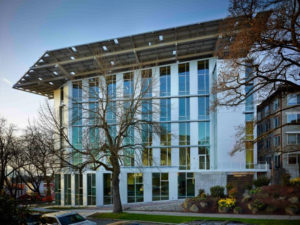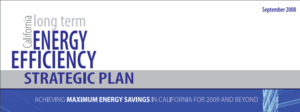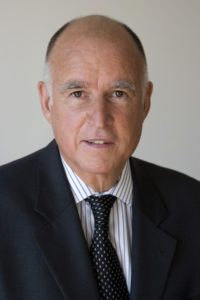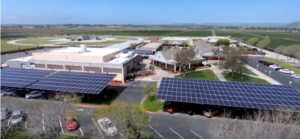In This Issue
Flanigan’s EcoLogic: Inspired by Net Zero 2018
Quote of the Week
Defining Zero Net Energy
California’s Zero Net Energy Initiatives
Global Climate Action Summit Update
NETs … Sucking Up CO2
Garren’s Picks of Environmental Apps
New EcoMotion White Paper and Webinar: Microgrids, Resilience, PERCs

Flanigan’s EcoLogic: Inspired by Net Zero 2018
The vibe was really exciting. In an International Brotherhood of Electrical Workers (IBEW) facility in Commerce, CA, marked by massive solar arrays, battery banks, and microgrid controls… what was dubbed the largest Net Zero conference ever was getting underway: Energy + Water + Waste + Transit.
Timely and relevant: Governor Jerry Brown had just signed SB 100 committing the Golden State to 100% renewable energy. Massive Hurricane Florence was forming off the Carolinas in the Atlantic, another vivid justification for the massive transformation to clean energy.
Like the State’s unprecedented Zero Net Energy goals, SB 100 is a huge step for California. Later in the morning, we’d welcome and hear from Senator Kevin De Leon. He authored and championed SB 100 and has by many accounts become the world’s most avant-garde environmental advocate.
Architect Jason McLennan impressed me. A self-proclaimed troublemaker, if there is anyone legendary in the ZNE world, it’s him. He founded the Living Building Challenge. He is certainly one of the most influential players in the architecture and green building movement.
McLennan set the tone for the day… at once sensitive, hard-hitting. He has a spiritual side, talked about love, and showed slides of his home, his family, kids, and dog. His vision for the Living Building Challenge was to stimulate the design of that go beyond LEED Platinum. He teamed up with Kansas City-based architect, Bob Berkebile, to create an international sustainable building certification program, what some told him was a crazy idea. The Living Building Challenge is now managed by the International Living Future Institute (ILFI).
The Living Building Challenge is rigorous and has seven performance areas, or what are called “petals:” Site, Water, Energy, Health, Materials, Equity, and Beauty. Buildings must be net positive in terms of energy and water. They must provide community value and be regenerative of natural systems. There are now 500 ILFI-certified buildings across the country.
Jason featured the Bullitt Center in Seattle as a showcase of sustainability and leadership. It was designed to be the greenest commercial building in the world. In its creation, Denis Hayes and others at the Bullitt Center figuratively had to move mountains. Literally they had to change the law – zoning ordinances and septic requirements – to get the job done.
Marked by its signature solar “mortar board,” the building has drawn international attention. It has six-story composting toilet system. Its rainwater collection system is backed with onsite treatment to create potable water. The Center is designed for a 250-year building life, versus the typical 40-year lifespan. It has four-hundred-foot deep geothermal wells for its heating and cooling.
Jason reminded us of the importance of our work. Yes, he’s pleased with our collective progress. But he stressed the imperative we now face. There’s now a smoke season in Seattle due to the wildfires. In California, fires are no longer seasonal. These extremes are stark examples of the impacts of climate change and the need to take swift action now.
It is always great to hear Kevin De Leon speak. Introduced as the son of a single immigrant mother, the first in his family to graduate from high school and college, his passion is genuine and pronounced. His drive to create a clean energy economy is not just for the elite. This movement is for the health and well-being and prosperity of our society.
De Leon made clear the importance of those in the room. While San Francisco’s concurrent Global Climate Action Summit was about policy, NZ 18 was about “the practitioners” or “the executioners” of policies he’s championed. He thanked those attending for proving it’s possible and profitable. We are the fifth largest economy in the world – only behind the U.S., China, Japan, and Germany – and growing with renewables.
There are now 500,000 workers in the clean energy space in California alone, compared to 50,000 coal miners nationwide. NZ 18’s 75 speakers and program drew attendees from all over the United States and several foreign countries. Workshops sandwiched the plenary day… packed with technical information and pragmatic insights on how to build to net zero.
A few themes struck me:
First, obviously, but wow… net zero is really possible! It’s doable and being proved again and again. It does not have to cost more either. I remembered Carlos Santana’s Grammy acceptance speech… “Am I dreaming?” This is fantastic! And its only getting better as more and more great minds join us in this transformation to clean energy… and to a higher quality of life.
My friend Jeff Horowitz presented NEXT solar windows. Instead of bolting solar onto rooftops and creating redundant building systems, why not embed solar in windows? The NEXT glass is clear; it is selling its compound semiconductor printing process to glass manufacturers such that every window will be a solar generator. While promoting solar, Jeff and his colleagues are focused on making solar glass appealing to the industry. Solar glass provides for major surface areas to be energy productive. Imagine.
Second, the equality and equity piece. I salute the diversity mandate and the rise of woman in the sustainability field. The conference featured an all-woman panel of utility leaders from Southern California Edison, Los Angeles Department of Water and Power, Pacific Gas and Electric, and Southern California Gas. These “power women” shared their experiences in a once male-dominated field and encouraged young women to join them.
Edison was proud to announce that it is promoting an income-qualified program option for renewable power that costs less. Shared mobility makes car ownership more affordable, while reducing the amount of parking required in commercial and multifamily settings.
Third. This is fun to watch if you have no stake. It’s not hard to sense the tension between those that accept natural gas and its spot uses – especially stove-top cooking – and those that want to eliminate this hydrocarbon altogether. An afternoon panel provided two case studies of significant savings when building all-electric net zero homes: No need to trench in gas, no need for gas piping in the house, no need for gas appliances. And they’re safer… NZ 18 took place just before the simultaneous Boston-area gas explosions. With heat pump systems that have efficiencies in the 200+% – for both space and water heating – and induction cooktops that are safe, controllable, and highly efficient, many are saying, “Who needs gas?”
Thanks to the Verdical Group for putting on this fifth Net Zero conference.



 California’s Energy Efficiency Strategic Plan written in September 2008 was the first integrated framework of goals and strategies to promote energy efficiency as the State’s highest priority resource.
California’s Energy Efficiency Strategic Plan written in September 2008 was the first integrated framework of goals and strategies to promote energy efficiency as the State’s highest priority resource. The Global Climate Action Summit in San Francisco in mid-September raised a good deal of attention. It was Governor Jerry Brown’s “swan song” as he terms out of office, and a strong statement to the world. Thousands of business leaders, politicians, advocates rallied in San Francisco at the Summit and to attend and participate in hundreds of affiliate events. The Governor was pleased that the Chinese sent a large delegation of government officials, researchers, and business leaders. China also organized three days of programming at the “China Pavilion” in partnership with the State of California.
The Global Climate Action Summit in San Francisco in mid-September raised a good deal of attention. It was Governor Jerry Brown’s “swan song” as he terms out of office, and a strong statement to the world. Thousands of business leaders, politicians, advocates rallied in San Francisco at the Summit and to attend and participate in hundreds of affiliate events. The Governor was pleased that the Chinese sent a large delegation of government officials, researchers, and business leaders. China also organized three days of programming at the “China Pavilion” in partnership with the State of California.
 A year ago,
A year ago, 
 Garren Bui, a Cal Poly San Luis Obispo engineering major, was a terrific summer intern at EcoMotion. When we heard he’d been developing his own app, we asked him to dig into the universe of environmental apps… and to steer our readers and network in the right direction.
Garren Bui, a Cal Poly San Luis Obispo engineering major, was a terrific summer intern at EcoMotion. When we heard he’d been developing his own app, we asked him to dig into the universe of environmental apps… and to steer our readers and network in the right direction.
